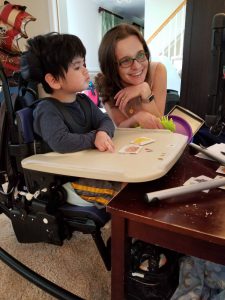 I was thrilled when my Journal of Early Intervention arrived this week with a study on the impact of sustained adult modeling of Augmentative Alternative Communication (AAC) with students with complex communication needs (CCN). I’m always excited to see AAC studies show up in special education journals. As the number of children are given access to AAC increases more studies are looking at how children develop language skills with AAC, and what are the best methods for teaching students with AAC. The more we know, the better we’ll be able to teach, so I quickly flipped open the study and read to see if it could help me in my work with Joey.
I was thrilled when my Journal of Early Intervention arrived this week with a study on the impact of sustained adult modeling of Augmentative Alternative Communication (AAC) with students with complex communication needs (CCN). I’m always excited to see AAC studies show up in special education journals. As the number of children are given access to AAC increases more studies are looking at how children develop language skills with AAC, and what are the best methods for teaching students with AAC. The more we know, the better we’ll be able to teach, so I quickly flipped open the study and read to see if it could help me in my work with Joey.
This particular study, Implementation and Intervention Practices to Facilitate Communication Skills for a Child with Complex Communication Needs, examined the use of teacher modeling and its impact on student use of AAC. It found that when modeling increased, the student’s unprompted functional communication use increased as well. Unprompted communication is what we strive for with all students. A child needs to be able to communicate with those around them without given prompts to do so. When we teach students to use an AAC device, we often begin by prompting them to use it. Eventually, we want the child to use the device independently, without relying on an adult to indicate the need to communicate. (This always reminds me of when I prompt my daughters to say thank you. At some point I get caught in a loop where I worry they won’t say thank you without my prompt. So I give them a prompt, and then they never have the opportunity to show their manners independently. Yet then they rely on me for the prompt, and never need to be independent in remembering to say thanks. It’s not really manners if your mom has to tell you to say it, right?) Can it be true, meaningful communication if you are just repeating or choosing words someone else has told you to say? If Joey only says “I want ball” when I tell him to do it, is it really a firm skill? Does he understand the concepts behind communication, and will he spontaneously be able to get his needs met?
The study noted that adults need to continue modeling AAC, even after a student appears to be functional in the skill. Modeling needs to occur across contexts, and is most effective in meaningful, motivating situations. The article states “This suggests that sustained modeling of AAC use may be critical for child communicative success, even after a child has demonstrated competence in basic communication (i.e. that communication attempts by children are influenced by current contexts and not just adequate initial teaching.)”
For me, this is an important reminder to constantly be modeling AAC to communicate for different reasons and in different contexts.
Chazin, K., Barton, E., Ledford, J., & Pokorski, E. (2018). : Implementation and intervention practices to facilitate communication skills for a child with complex communication needs. Journal of Early Intervention, 40(2) 138-157.


